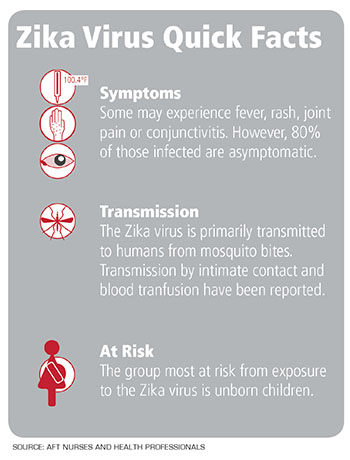People who traveled to countries where the Zika virus is present have come down with illness here in the United States, sparking concerns about the increase in summer travel and the need for education and awareness.
"We are following the CDC guidelines and the DOH guidelines," said Anne Goldman, United Federation of Teachers vice president for non-department of education employees. "The concern in particular is with regard to pregnant women or those planning to become pregnant. The advice is to postpone pregnancy and to realize the male may also transmit the Zika virus to the fetus.
 "So, as with all communicable diseases, we follow the guidelines, attend city conferences and refer the information to our members. [We also make sure] employers provide updates to our members as it becomes available," Goldman added.
"So, as with all communicable diseases, we follow the guidelines, attend city conferences and refer the information to our members. [We also make sure] employers provide updates to our members as it becomes available," Goldman added.
Guidelines, issued by the Centers for Disease Control, include avoiding mosquitos, removing standing water where mosquitos could breed and using insect repellents.
"As to diagnosis, it is detected by symptoms and bloodwork," Goldman said. "We are also awaiting federal funding that was promised to get to work on a vaccination."
The mosquito-born virus is an important reminder for people to take care while working or playing in the outdoors to avoid vector-born diseases carried by mosquitos, ticks and fleas.
"The Zika virus reminds us we have to be careful of other mosquito-borne illnesses, including the West Nile virus," said Wendy Hord, NYSUT health and safety specialist. CDC reports show the West Nile virus is present in the U.S. While most people will have no symptoms, up to 1 in 5 infected individuals will develop a fever with other symptoms, such as headache, body aches, joint pains, vomiting, diarrhea or rash.
Also of ongoing concern is the potential for contracting Lyme disease and other emerging tick diseases.
"Tick-born illnesses can be devastating," said Hord.
People who work outside in the summer, including NYSUT members who are lifeguards, groundskeepers, maintenance crew and coaches, face additional risks, Hord pointed out.
The CDC's Division of Vector- Borne Diseases explains that both bacterial and viral diseases can be transmitted by mosquitos, ticks and fleas. While some diseases have been present for a long time in this country, others are creepy crawling their way into the news.
The statistics are alarming:
- Lyme disease causes more than 300,000 estimated human illnesses annually in the U.S.
- Tick-borne rickettsial diseases, such as Rocky Mountain spotted fever, ehrlichiosis and anaplasmosis, are responsible for more than 4,000 U.S. cases each year, including some that result in death.
Protection from ticks includes fully covering skin while in wooded and bushy areas; checking skin thoroughly after being outdoors; and putting clothes worn outdoors in the dryer on high heat for 10 minutes before washing them.
For more info
In February 2016, the World Health Organization declared the Zika virus a "public health emergency of international concern." Common symptoms are fever, rash, joint pain and conjunctivitis. Illness is marked with generally mild symptoms lasting for several days to a week after being bitten by an infected mosquito.
The Zika virus infection during pregnancy can cause a serious birth defect called microcephaly, as well as other severe fetal brain defects.
As of June 8, 691 travel-related cases of Zika were reported in the U.S., with zero locally acquired vector-borne cases.
For more information on the Zika virus, visit www.cdc.gov/zika/index.html.
To learn more about Lyme disease, visit www.lymedisease.org.